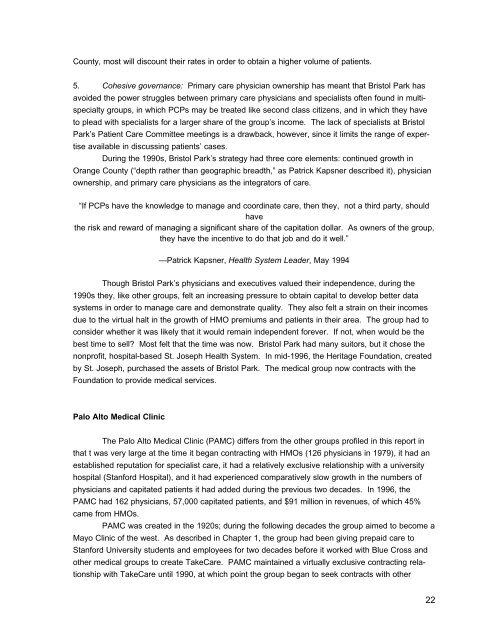The Evolution of Medical Groups and Capitation in California
The Evolution of Medical Groups and Capitation in California
The Evolution of Medical Groups and Capitation in California
Create successful ePaper yourself
Turn your PDF publications into a flip-book with our unique Google optimized e-Paper software.
County, most will discount their rates <strong>in</strong> order to obta<strong>in</strong> a higher volume <strong>of</strong> patients.5. Cohesive governance: Primary care physician ownership has meant that Bristol Park hasavoided the power struggles between primary care physicians <strong>and</strong> specialists <strong>of</strong>ten found <strong>in</strong> multispecialtygroups, <strong>in</strong> which PCPs may be treated like second class citizens, <strong>and</strong> <strong>in</strong> which they haveto plead with specialists for a larger share <strong>of</strong> the group’s <strong>in</strong>come. <strong>The</strong> lack <strong>of</strong> specialists at BristolPark’s Patient Care Committee meet<strong>in</strong>gs is a drawback, however, s<strong>in</strong>ce it limits the range <strong>of</strong> expertiseavailable <strong>in</strong> discuss<strong>in</strong>g patients’ cases.Dur<strong>in</strong>g the 1990s, Bristol Park’s strategy had three core elements: cont<strong>in</strong>ued growth <strong>in</strong>Orange County (“depth rather than geographic breadth,” as Patrick Kapsner described it), physicianownership, <strong>and</strong> primary care physicians as the <strong>in</strong>tegrators <strong>of</strong> care.“If PCPs have the knowledge to manage <strong>and</strong> coord<strong>in</strong>ate care, then they, not a third party, shouldhavethe risk <strong>and</strong> reward <strong>of</strong> manag<strong>in</strong>g a significant share <strong>of</strong> the capitation dollar. As owners <strong>of</strong> the group,they have the <strong>in</strong>centive to do that job <strong>and</strong> do it well.”—Patrick Kapsner, Health System Leader, May 1994Though Bristol Park’s physicians <strong>and</strong> executives valued their <strong>in</strong>dependence, dur<strong>in</strong>g the1990s they, like other groups, felt an <strong>in</strong>creas<strong>in</strong>g pressure to obta<strong>in</strong> capital to develop better datasystems <strong>in</strong> order to manage care <strong>and</strong> demonstrate quality. <strong>The</strong>y also felt a stra<strong>in</strong> on their <strong>in</strong>comesdue to the virtual halt <strong>in</strong> the growth <strong>of</strong> HMO premiums <strong>and</strong> patients <strong>in</strong> their area. <strong>The</strong> group had toconsider whether it was likely that it would rema<strong>in</strong> <strong>in</strong>dependent forever. If not, when would be thebest time to sell? Most felt that the time was now. Bristol Park had many suitors, but it chose thenonpr<strong>of</strong>it, hospital-based St. Joseph Health System. In mid-1996, the Heritage Foundation, createdby St. Joseph, purchased the assets <strong>of</strong> Bristol Park. <strong>The</strong> medical group now contracts with theFoundation to provide medical services.Palo Alto <strong>Medical</strong> Cl<strong>in</strong>ic<strong>The</strong> Palo Alto <strong>Medical</strong> Cl<strong>in</strong>ic (PAMC) differs from the other groups pr<strong>of</strong>iled <strong>in</strong> this report <strong>in</strong>that t was very large at the time it began contract<strong>in</strong>g with HMOs (126 physicians <strong>in</strong> 1979), it had anestablished reputation for specialist care, it had a relatively exclusive relationship with a universityhospital (Stanford Hospital), <strong>and</strong> it had experienced comparatively slow growth <strong>in</strong> the numbers <strong>of</strong>physicians <strong>and</strong> capitated patients it had added dur<strong>in</strong>g the previous two decades. In 1996, thePAMC had 162 physicians, 57,000 capitated patients, <strong>and</strong> $91 million <strong>in</strong> revenues, <strong>of</strong> which 45%came from HMOs.PAMC was created <strong>in</strong> the 1920s; dur<strong>in</strong>g the follow<strong>in</strong>g decades the group aimed to become aMayo Cl<strong>in</strong>ic <strong>of</strong> the west. As described <strong>in</strong> Chapter 1, the group had been giv<strong>in</strong>g prepaid care toStanford University students <strong>and</strong> employees for two decades before it worked with Blue Cross <strong>and</strong>other medical groups to create TakeCare. PAMC ma<strong>in</strong>ta<strong>in</strong>ed a virtually exclusive contract<strong>in</strong>g relationshipwith TakeCare until 1990, at which po<strong>in</strong>t the group began to seek contracts with other22


